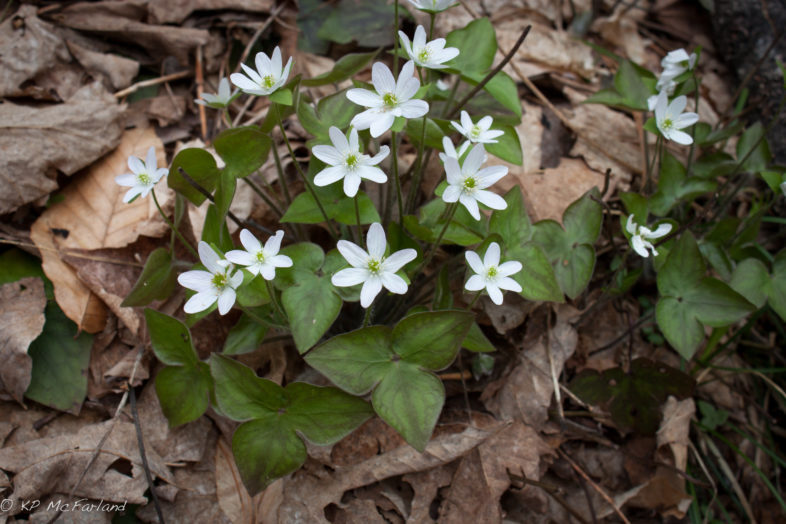
Sharp-Lobed Hepatica flowering in the forest understory before the trees leaf out. / © K.P. McFarland
In April the northern forest is laid bare with cold desire. Our long dormant senses awaken.The sweet smell of soil rises to our nose. As the soil warms, Streptomyces bacteria spew chemical weapons against other bacteria, which to us have a distinct earthy smell. Our ears cock skyward at dusk as a Woodcock chatters and twitters across the sky. Spring Peepers burst forth in the evening with up to 4,000 peeps an hour. Blades of wild leeks slice through the soggy, brown remains of autumn to release sweet-onion perfume. Bright white Hepatica opens for wild bees and provides a feast for our eyes. The smell of smoke can fill the air. For a short time before the forest turns green, fires can quickly run through the understory. April leaves none of our senses void. Here’s our guide to some of the joys of April.
A FIELD GUIDE TO THE SKY DANCE
A sign of spring for us is an evening trip to the theater to watch what Aldo Leopold called the sky dance in his 1949 classic A Sand County Almanac. Our theater has no roof and no seats. It’s just a small field next to a shrubby wetland near our house with a show that is something to behold. It’s the annual courtship flights of the American Woodcock and this year on a crisp, clear night it was an especially beautiful show.
The dancers in this annual show have a long bill with a flexible tip specialized for probing and capturing earthworms, a stout head with large eyes set far back for rearview vision without a mirror, and plumage with mottled, leaf-brown patterns that blend superbly with the forest floor.
The theaters they use are made of moist woodlands or thickets near fields or open areas. The audience is encouraged to arrive early and remain quiet while they let their eyes slowly adjust to the dimming light. The curtain usually opens with the male woodcock flying onto the stage at exactly 22 minutes after sunset when the lights are dimmed to precisely 0.05 foot-candles. With the crowd hushed, the dancers begin.
The males are loosely clustered about the stage. Each defends a small area on the ground were the peent, a short (~0.2 seconds) buzzy note is repeated over and over. If you are close enough you can also hear each peent preceded by a short (0.3 seconds) tuukoo, wukoo or ka-rurr sound. The two sounds often merge into one, tuukooeeent. He may also givetuukoo calls at widely separated intervals (0.2–30 seconds) initially after alighting on display area or when alert to strange sounds.
The sky dance begins when the “peenting” bouts end. There are five parts to the flight:
- a silent, gradual ascent lasting about 2 seconds;
- a continued gradual ascent with light wing twittering for about 12 seconds;
- the wing twittering becomes melodious as he climbs steeper and then loops into spirals for about 15 seconds;
- the apex of the flight lasts for about 12 seconds and may be 300 feet high, as the wing twittering becomes intermittent with rapid, short bursts, overlapping with loud, vocal chirping during the initial descent as he zig-zags, dives, and banks, then pitching down again precipitously;
- a silent descent lasts up to 8 seconds as he brakes to the ground with soft but audible flapping wings and lands back on his stage to resume another bout of peenting.
Listen as this bird peent calls repeatedly and then takes to the air for his twittering flight:
The twittering sound is produced by air passing between three attenuated outer primary feathers on the wing. The outer primaries of a male American Woodcock are narrowed (called emarginated), which produces whistling twitters during the sky dance. The chirping calls made during the sky dance are a fast, repetitive series of 4–6, melodious notes – chirp-chirp-Chirpchirpchirp, repeated.
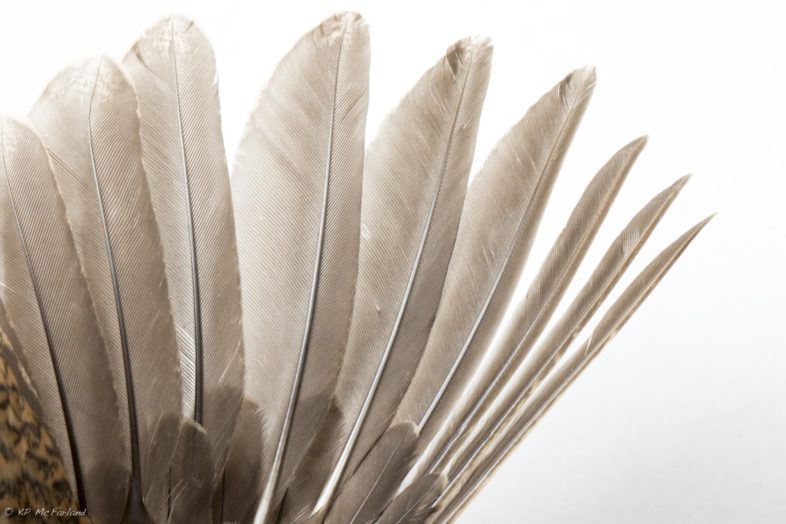
American Woodcock wing from a bird that had been hit by a car. The three flight feathers at the end, which are reduced in size, make the whistling sound as the fly overhead displaying. / © K.P. McFarland
Sometimes they will give a rapid, harsh cackle, ca-ca-ca-ca-ca , as they fly low over another peenting male. Cackling is probably an aggressive challenge. Sometimes the peenting bird may chase the aggressor and cackle back. If two peenting males are too close to each other, they may give aggressive cackle calls on the ground too.
As many as 24 sky dances can be performed by an individual during an evening performance, but most average a half dozen per night. As twilight disappears from the western sky, the performers retire for the night and wait for the curtain to rise in the dim light of the morning for another bout of sky dancing.
Join Outdoor Radio on a Woodcock walk with Mad River Birders last year and report your sightings on Vermont eBird.
How Often Does Fire Burn the Northern Forest?
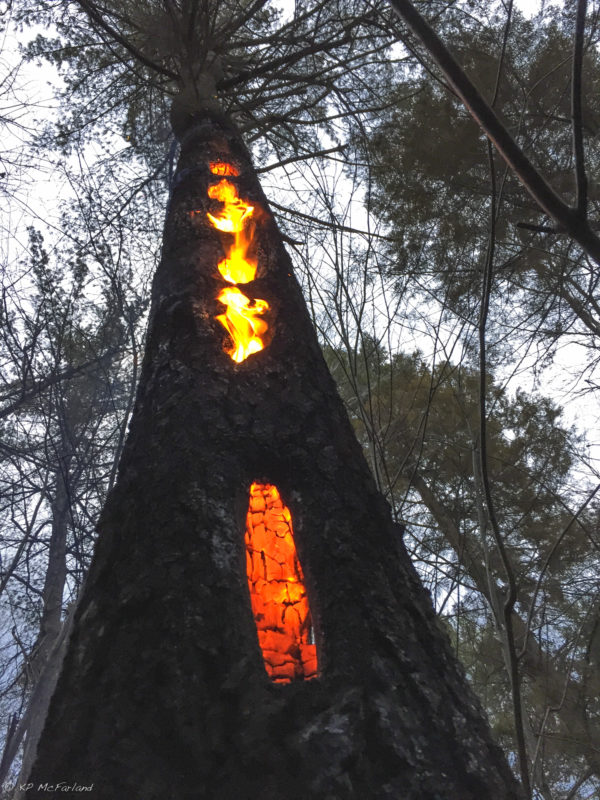
Spring forest fire encounters a hollow tree where a Pileated Woodpecker searched for food. / © K.P. McFarland
The hardwood forests in our region are generally susceptible to fire each year during two very short, dry periods. The first is when mud season has just about ended and the flush of green understory plants has yet to break ground from spring rains. The leaf litter from the previous fall can be as dry as paper. The second period is in late fall, when the trees stand naked after the leaves have fallen and the leaf peepers have all gone home. In a dry year, the newly fallen leaves can easily kindle a forest fire.
But fires in the hardwood forests of northern New England are relatively rare, as evidenced by the fact that the forest is not fire-adapted like the pitch pine forests found in scattered locations across the northeast. Even in the southern New England hardwood forests, many of the trees, such as oak, hickory, and red maple, sprout vigorously from burned stumps and trunks after a fire. But the northern hardwood forest is comprised of more fire-sensitive species such as hemlock, beech, and sugar maple. Anything more than a quick ground fire can kill a mature tree in the northern hardwood forest.
How often do forest fires roll through a typical northern hardwood forest? Recently, researchers from Harvard Forest in Petersham, Massachusetts, studied ancient charcoal and pollen for the answer. The scientists sampled four lakes in northern hardwood forests using a tool that sinks into the underwater muck and retrieves a solid core of sediment. Each layer of sediment was examined for microscopic fossil charcoal and pollen. Ages of each layer were determined using radiocarbon dating, with the timing of European settlement noted by decreases in the amount of tree pollen and increases in pollen from plants such as ragweed and grasses that were rare or absent before.
Comparing the northern hardwood forest cores to those from other New England forests showed that fire is quite rare in northern hardwood forests, with a given area being burned only once every 1,000 years or more prior to European settlement. Our cool, moist northern hardwoods are not easily ignited. When they do burn, it is usually a light burn through the relatively moist leaf litter.
Three of the sites had significant increases in charcoal after European settlement, ranging from a 5- to 10-fold increase between pre-settlement and post-settlement times. In fact, today, over 95 percent of all forest fires in the region are caused by human activity.
We often hear that Native Americans burned large tracts of forest regularly In New England. In 1632, Thomas Morton, living near Boston, famously wrote, “…set fire of the Country in all places where they come; and to burne it, twize a year, vixe at the Springe, and the fall of the leafe.” However, that was in southern New England, close to the coast. There is little evidence that fire was ever used frequently, if at all, in our local northern hardwood forests, where Native American populations were much lower.
Evidence of fire can be found in a forest for many years afterward, and some clues are relatively easy to identify. Hot, slow fires leave two obvious signs: basal trunk scars and multiple-trunked trees. But be careful – so may past logging operations. With a fire, basal scars will be more randomly distributed than logging scars in flat areas or, on hillsides, will be found only on the uphill side of the trunk. Why only on the uphill side? Think about leaf litter and gravity; the leaves and twigs slide slowly down the slope only to be stopped by a tree trunk, where they gather like water behind a dam. As fire passes and wraps around the trunk, it encounters the deeper leaf litter, which burns slower and hotter than the thin cover below the trunk, biting through the bark of the tree and leaving a triangular scar.
Finding charcoal as a clue to a past forest fire is much more difficult. Charcoal breaks down and is generally not visible after just a few years. Dead wood, especially beech and maple, often has a smooth, black coating that has the appearance of being charred but isn’t. This is actually a fungus and is part of the natural decaying process. But it’s still worth a try to find evidence of one of our local forests’ rarer phenomena.
Unlike other forest types, such as the Ossipee and Concord pine barrens in se New Hampshire, hardwood forest here in northern New England don’t depend upon fire for its ecological health.
Synchronized Swimming
The next act in this vernal drama happens with the next warm rains of April. Vernal pools come alive with mating amphibians. Stars on this stage here in Vermont include Spotted and Jefferson’s Salamanders, Wood Frog, Spring Peepers, and more. In April, You can find many of these courting and mating in ponds at night.
Male Spotted Salamanders leave their hibernation burrows ahead of the females and arrive first at the pools. They form large balls of wiggling males called congresses. As females arrive, individual males separate from the congress and perform a courtship dance with a female. They circle and put their heads under each other’s tails. The male may climb on her back and rub her with his chin. He then swims away wiggling his tail. If the female is interested, she will follow him. He leads her to a sperm packet, called a spermatophore, he deposited earlier on submerged leaves or twigs on the bottom of the pool. She picks up a packets through her cloaca, an opening under the base of the tail used for egg-laying, excreting waste, and of course egg fertilization. The female may collect packets from several males. She then lays several hundred eggs in small gelatinous balls.
Grab a headlamp and your raincoat and go out and witness this magical dance at a vernal pool near you. You can learn where vernal pools might be, and report any you find, to our vernal pool project.
The Eagle Has Landed
Historical information on bald eagles in Vermont is limited; however, eagles were considered rare summer residents in the early 1900s. A pair was known to have nested on Lake Bomoseen in the central part of the state in the 1940s. In 2002, the first Vermont eagle nest was discovered after a 60-year absence. However, it wasn’t until 2008 when the first eagle fledgling successfully left its nest in Concord, and then two more nests were confirmed in 2009. Eagle numbers have been steadily increasing since then, giving hope to their full recovery in the near future.
Vermont’s Bald Eagle population continued its recovery in 2017. Twenty-one pairs of adult Bald Eagles successfully produced 35 young in Vermont in 2017, a modern-day record in the state according to the Vermont Fish & Wildlife Department. The species remains on Vermont’s endangered species list, but another strong year of growth has biologists hopeful for their continued recovery.
Bald Eagles typically nest along significant water bodies where fish and other aquatic foods are readily available. In Vermont, most bald eagle nests are found along the Connecticut River, Lake Champlain, Lake Memphremagog, and some other large inland bodies of water. Bald eagles typically nest in tall trees with broad visibility and sturdy branches located near lakes and rivers. Adults show a strong tendency for fidelity to their breeding areas, and will often use the same nest for many years. The nest tree requires sturdy branches to support the growing weight of the nest as materials are added each year. Nests are usually located approximately 50 to 60 feet high and 5 to 30 feet below the top of a live tree.
Egg-laying generally begins from early March through as late as early May in the Northeast. Clutch sizes range from one to three eggs. Incubation lasts about 35 days. Competition for food in the nest can be fierce and the youngest chick often dies. Fledging occurs at 11 to12 weeks after hatching. Parental care may continue for up to three months after they leave the nest. The entire breeding cycle, from courtship to fledgling independence, takes at least six to seven months.
Bald Eagles declined in the 20th century nationwide due to loss of habitat, disturbance to nests, and the effects of the pesticide DDT. Laws such as the Clean Water Act, the Endangered Species Act, and a ban on DDT have aided in the recovery of these birds
You can see where eagles have been sighted on Vermont eBird. If you find a nest site, please report it to the Vermont Fish & Wildlife Department or VCE. Please do not approach or disturb nesting areas.
From a Peep to a Cacophony
It’s a warm evening and the only sign of snow are the eroding piles beside the driveway. The spring peepers are in stereo. Down in the valley there is a chorus erupting and up on the hill in a pond another is just beginning to call. Spring has finally sprung.
The cacophony of calling is made up of hundreds of male spring peepers. Each peep call is made by forcing air from their lungs over vocal cords in the larynx and into an air sac in their throat. The air enters the sac from openings on each side of the mouth cavity causing it to balloon outward with air. The inflated sac amplifies and transfers the sound energy from the frog to my ears across the valley.
What sounds like chaos to me, is not to a peeper. Several males may interact vocally by forming duets, trios or quartets, with alternating peep calls and individual pitches. When males alternate calls, one individual, the follower, usually calls within 40 to 70 milliseconds from the end of the leader’s call.
Males tend to stay within an auditory threshold of each other. Spacing and timing of calls accentuates the distinctiveness of each male’s calls so that it is not lost in the din of the chorus and allows a female to zero in on a single calling male. When another calling frog is too close, they may use a second type of call, a trill. The trill seems to reflect a higher degree of aggression than the peep call and may stimulate another individual to move away or to trill back, causing a trill-off. A trill-off can escalate into a brief physical interaction with the winner staying and the loser moving on to quieter waters.
Each male peeper can pump out from 3,000 to 4,000 peeps an hour for several hours each night. So it is not surprising that male trunk muscles, which help propel air from the lungs, average 15 percent of their body mass compared to only 3 percent for the quiet females. Aerobic capacity of trunk muscle is six times that of leg muscles and 17 times greater than female trunk muscle. Peepers derive about 90% of their energy for call production from fat reserves in these muscles. Males weigh on average about the same as two dimes, yet their sound pressure is comparable to the song of a warbler (about 4 quarters in weight) or a blackbird ( a whopping eight half dollars in weight). These little peepers have big bellows.
The peeper mating system is based on female choice. The louder and faster he peeps, the better his chances of attracting a receptive female. When females were presented with recorded peep calls, they preferred peep rates double to those found in the wild. So there is strong sexual selection for males that can peep fast. Because of the strong directional selection for fast calling rates, males perform at or close to their physiological limits. But one night of binge calling doesn’t seem to wear them out. Males that have the higher peep rates in one night tend to have higher peep rates every night.
The evening temperature also affects calling patterns. On warmer evenings peepers call much more frequently. The consumption of oxygen increases with calling rate, which in turn increases with temperature. At a balmy 60 degrees peep calls are repeated up to 13,500 times per night.
All males don’t sing though. The bigger the chorus the more silent males one might find hanging around. These shy guys tend to be smaller than the big singers. They quietly wait near a good singer watching for a female that may be attracted to the peeps. And when she comes along, they use their quickness and agility to beat the singer to the female.
According to the Vermont Amphibian and Reptile Atlas, peepers can begin calling as early as March 15th with peak activity in early May. Chances are good that the spring peeper chorus is now earlier than in the past, according to a study by James Gibbs, from the State University of New York in Syracuse, and Alvin Breisch of the New York Department of Environment Conservation.
From 1900 to 1912 Albert Wright, an instructor in zoology at Cornell University, visited ponds around the campus daily each spring to record the date of the first calls of frogs. Ninety years later volunteers collected the same kind of information for the New York Amphibian and Reptile Atlas, allowing Gibbs and Breisch a chance to compare. Wright heard his first peepers on April 4th. Atlas volunteers heard them on average around March 20th, about 13 days earlier.
For us, it is spring music to our ears. For the peepers, it is a singing battle of life and death. I hope their spring tradition goes on and on.
Migrant Dragonflies Arriving at a Pond Near You
A mere three inches long and weighing just four-hundredths of an ounce, it’s sailing on four wings thousands of feet in the air. With little fanfare, it struck northward. This Common Green Darner dragonfly is following spring north and it will likely be the first dragonfly you see this April in the Northeast. Of North America’s over 330 dragonfly species, only nine regularly migrate.
Dragonfly migrations have been observed on every continent except Antarctica, with some species performing spectacular long-distance mass flights. A dragonfly called the Wandering Glider is the long-distance champion, making flights across the Indian Ocean that cover twice the distance of Monarch butterfly migrations.
North America’s most abundant and widespread migrant dragonfly is the Common Green Darner. In the spring, just after the ice has disappeared from the ponds, they suddenly appear, well before any local dragonflies have emerged. These are migrants from the south, having flown from perhaps Florida, the Caribbean, or Mexico. They breed soon after arriving, and their nymphs develop quickly in water warmed by the spring and summer sun. Many adults emerge from the ponds in August. They feast on insects to pack on fat, perhaps increasing their weight by up to a third. But instead of breeding at their natal site, they begin a southward migration ion autumn that may span a month or even longer.
Migrating only during daylight hours, as far as we know, Green Darners can fly more than 60 miles a day with favorable tailwinds. When the winds turn against them, they stop, sometimes for several days, to dine on mosquitoes, gnats, flies and other insects until the winds urge them onward.
Riding on hot winds from the south, the first Common Green Darners arrived on a Vermont pond as early as mid-April. A few of these dragonflies may have come from as far away as the Yucatan peninsula in Central America or one of the islands in the Caribbean, over 2,000 miles away, while others were perhaps from as close as coastal North Carolina. Their young will take advantage of ample water and prey in the pond and journey back southward before the ponds are locked tight by ice.
It turns out that Common Green Darners are a lot like people; some are only here during fair-weather seasons, while others prefer to stay for the winter. Darners in more northern regions like Vermont are known to consist of both resident and migratory individuals. Both can inhabit the same pond, but exhibit strikingly different phenologies that appear to limit breeding between the two. Migrants arrive at breeding ponds in April, and larvae emerge as adults about five months later and start their migration southward. Meanwhile, resident darners don’t begin their breeding cycle until summer. Their larvae overwinter in the ponds under the ice, finally emerging as adults a year later.
Water temperature probably plays a role. Mature larvae of migratory darners raised in a laboratory required a minimum water temperature of about 48 degrees to develop into adults. Meanwhile, those that overwinter required higher temperatures for a longer period of time than migrants to develop into adults. The ratio of migrants to resident common green darners could vary from north to south with associated changes in water temperatures in ponds.
With over 300 million years of evolution behind them, about twice as long as birds, dragonflies have been flying around the globe for a long time.
Wolf Trees
Like a lone wolf, the huge Sugar Maple with branches stretching wide stood out among the younger and straighter trees in the forest. It was probably over 150 years old and even though it couldn’t talk, it told a story.
Years ago these massive trees were nicknamed “wolf” trees. It could have been for their solitary stance in the forest. Or perhaps for the belief that they were greedy with space and nutrients at the expense of other trees that had more commercial value. From the perspective of a forester, these trees were just pests, like many viewed wolves at the time.
When forests were cut and rocks piled into fence lines across Vermont to make way for agriculture, often Sugar Maple trees were left along the fencerows or lanes to be tapped for making maple syrup. As the trees grew in the open without competition from others, their branches grew outward rather than upward and their trunks became massive as they aged. As farms were abandoned and the forests of Vermont regrew, young trees sprouted around them and with competition, grew quickly upward with straight trunks and few branches.
Many of these old wolf trees show damage not just from old age, but from the vagaries of growing alone and in the open. The tops of their trunks are often broken and gnarled. The tallest object standing in the open invites a lightning strike from a summer thunderstorm. Their huge spreading branches may be broken and scarred from winter gales and snow and ice loads.
These stately old trees are a favorite of wildlife. Their huge trunks are often hollow and are attractive as den sites. I once found a pair of young Fisher playing with the tail of a dead squirrel outside their wolf tree den. The oblong circles drilled into the old trunks by Pileated Woodpeckers are signs of good feeding. In a young forest, these old trees are biodiversity oases.
The next time you see a wolf tree in the forest, take a close look at it and see what wildlife sign you find and share your photos of these forest giants with all of us on iNaturalist Vermont.
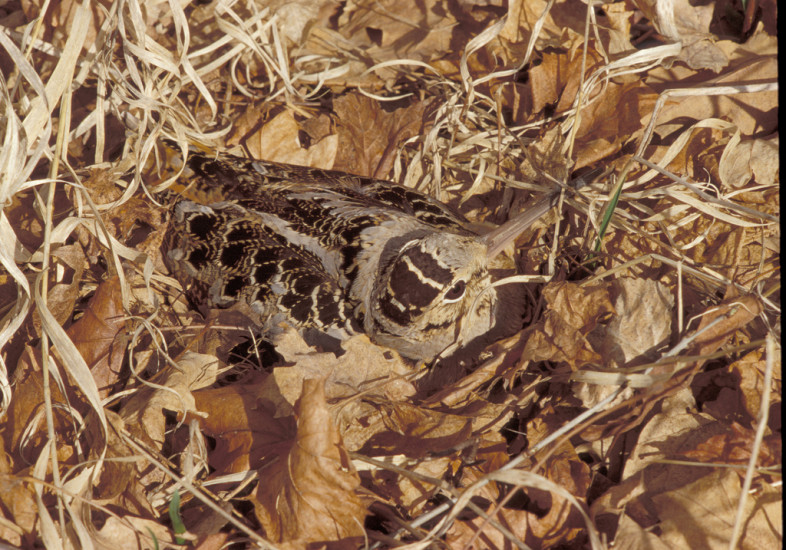
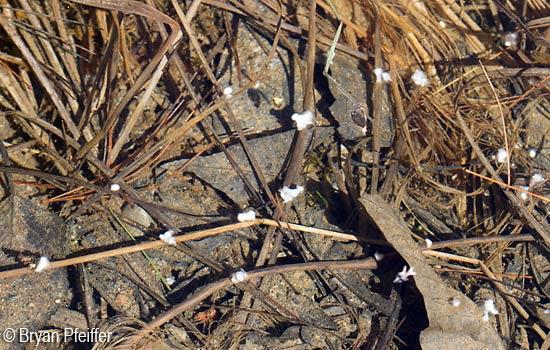
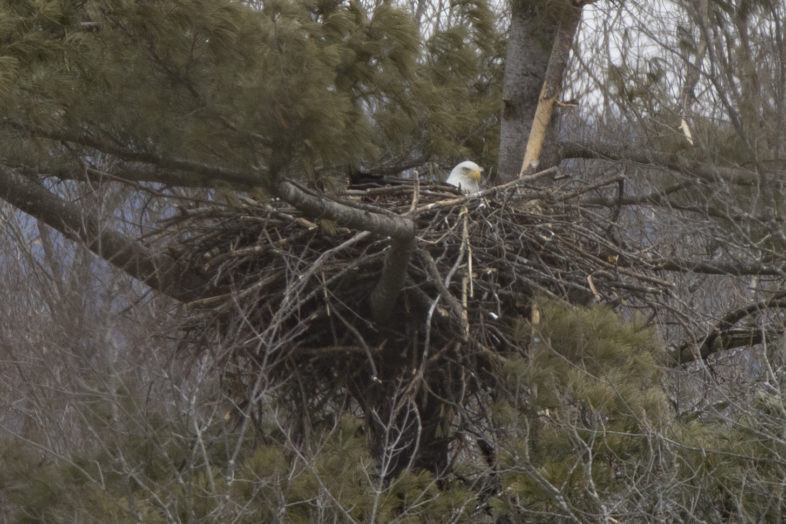
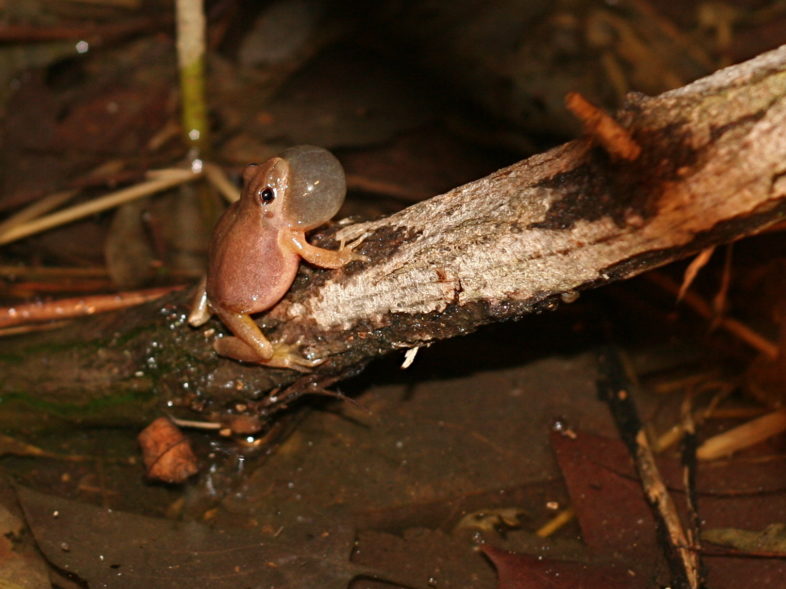
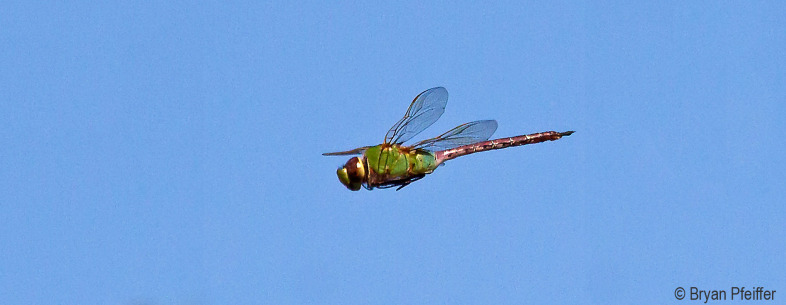
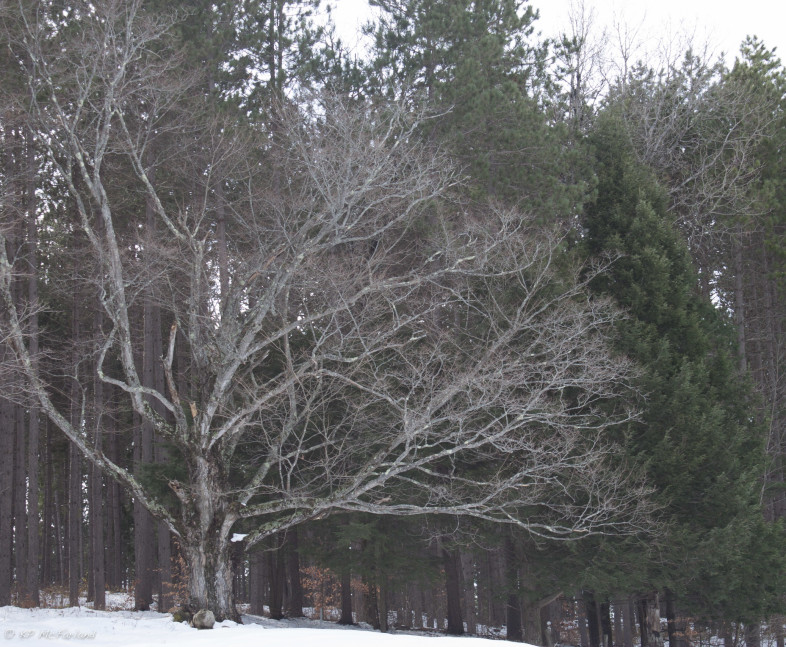

Nice article and photos.
💕💕💕Spring!
This is wonderful to watch! Thank you!